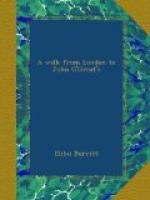The good Miller of Houghton, having added stone to stone until his mills can grind all the wheat the largest county can grow, has recently handed over to his sons the great business he had built up to such magnitude, and retired, if possible, to a more active life of benevolence. One of his late benefactions was a gift of 3,000 pounds, or nearly $15,000, toward the erection of an Independent Chapel in St. Ives.
At Huntingdon, I took tea and spent a pleasant hour with the principal of a select school, kept in a large, dignified and comfortable mansion, once occupied by the poet Cowper. In the yard behind the house there is a wide-spreading and prolific pear-tree planted by his hands. This, too, was one of the thousands of old, stately dwellings you meet with here and there, which have no beginning nor end that you can get at. Cowper lived and wrote in this, for instance; but who lived in it a century before he was born? Who built it? Which of the Two Roses did he mount on his arms? Or did he live and build later, and dine his townsman, the great Oliver, or was he loyal to the last to Charles the First? These are questions that come up, on going over such a building, but no one can answer them, and you are left to the wisdom of limping legends on the subject. The present occupant has an antiquarian penchant; so, a short time after he took possession of the house, he began to make explorations in the walls and wainscotings, as men of the same mind have done at Nineveh and Pompeii. Having penetrated a thick surface of white lava, or a layer of lime, put on with a brush “in an earlier age than ours,” he came upon a gorgeous wall of tapestry, with inwoven figures and histories




